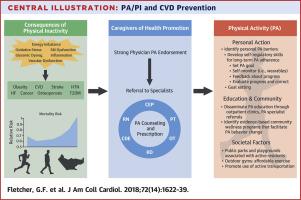Physical inactivity is recognized as an important modifiable risk factor for premature death and noncommunicable diseases, posing a major global health threat [1]. There is evidence of the effectiveness of regular physical activity in the prevention and treatment of several diseases, e.g., cardiovascular disease, diabetes, cancer, hypertension, obesity, and depression [2]. However, despite convincing evidence for physical activity, more than a quarter of all adults worldwide do not reach the public health recommendations of at least 150 min of physical activity per week at a moderate to vigorous level, and thereby more than 1.4 billion adults are at risk for development of diseases due to physical inactivity [3].

Health care potentially has an important role in promoting physical activity because many individuals who visit health care for various health problems have a higher probability of being physically inactive [4, 5]. Sweden and several other countries have implemented physical activity on prescription (PAP) programs to achieve increased physical activity among patients consulting health care [6,7,8,9,10]. The PAP program in Sweden is promoted in the Swedish National Board of Health and Welfare’s National Guidelines for Methods of Preventing Disease [11] and by the Swedish Public Health Agency [12]. The program was first implemented in 2001 as part of a national campaign “Sweden on the move” and is now used by all 21 regions responsible for providing health care in Sweden. Recently, the Swedish PAP program was chosen as a best practice program by the European Commission to be implemented in other European Union member states [13, 14].
Despite widespread implementation of PAP in Sweden, there has been some debate whether there is sufficient evidence of its effectiveness to support continued use of the program in routine practice [15,16,17]. Several studies have generated evidence of the Swedish PAP program in terms of patients’ adherence to the written prescription of physical activity [18], and regarding patients’ changes in physical activity levels [19,20,21,22] and other health-related outcomes [19, 21,22,23,24]. However, few studies have been conducted under circumstances of routine care to investigate the factors that have influenced changes in physical activity among patients receiving PAP in health care. The existing studies of PAP in Sweden have not provided any information about how the components of the program, such as counseling and support after receiving PAP, influenced changes in physical activity after prescription [18, 25, 26]. Qualitative research from a patient perspective has highlighted that patients need support to be able to change physical activity after receipt of PAP [27, 28]. Studies suggest the importance of social support for patients receiving PAP [29,30,31]. Previous studies by the researchers behind the present study have indicated that counselor support in association with delivery of PAP is beneficial for increased physical activity [28, 32]. However, the association between counselor support and other factors has not been elucidated.
Addressing key knowledge gaps in research on the Swedish PAP program, the aim of this study was to investigate the patient and health care characteristics associated with increased physical activity 1 year after prescription among patients prescribed physical activity in routine care with access to counselor support. This knowledge is important for improved understanding of the factors that influence patients’ physical activity after PAP [33], especially regarding counselor support. Such knowledge could be important for further development of delivery of PAP in routine health care. This study also adds information on patients receiving PAP in both primary and secondary care, which is important considering that most previous PAP studies in Sweden and other countries focused only on primary care.
